“We can wipe up the footprints with our shirts,” I said.
“Yeah, but that’s only part of the problem,” said Raskol. “We’ve left our footsteps in the dust on the terrazzo. We’re going to have to put it back the way it was.”
“What?”
“We’re going to have to rearrange the dust,” he said.
We returned to the entry, got down on our hands and knees, and, using our hands and puffs of breath, spread the dust around in a good imitation of its condition when we had arrived. Terrazzo dust is a demanding medium, fine and unforgiving, choking and dirty. I hope I never have to work in it again.
That left our footprints, extending down the hall. When we had finished wiping them up with our shirts, I was ready to call it a night and go home, but Raskol had noticed something new; “Hey,” he said. “Look at those tags.”
Looking down the corridor, I saw yellow tags attached to each locker, folded flaps of paper, like butterflies that had lighted there. I got up, pinched one, and opened it. On it was printed the combination of the lock that had been installed in the door.
“Hey,” said Raskol from the other side of the hallway. “You see what’s on these tags?”
“Yeah,” I said. “The combinations.”
He thought for a minute. “You got any paper with you?” he asked.
“Sure,” I said. In those days I always carried a small wire-bound notebook.
“Copy these combinations, okay?”
“All of them?”
“Yeah, all of them. Better get them all.”
“That’s going to take some time.”
“Okay, we’ll do them in shifts. You go on and get some, and when you get tired come back here and I’ll take over. Be sure to write down the number of the locker, too.”
“Okay,” I said.
I wandered through the school for a while, jotting down locker combinations until I felt I’d done my share. When I got back to Raskol, he had one of the locks apart.
“And look at this,” he said, as if I’d been standing beside him all along. “Just two bolts hold these locks in the door. See? You can take one off in a few seconds—if you’ve got the door open. Now watch this. This little cap with the numbers printed on it fits onto this shaft and over the splines.”
Splines. What a nice word. This was my first encounter with it. It appealed to me at once. It seemed inherently poetic, sensual. In fact, it sounded so good that I could imagine lots of uses for it, none of which was related to combination locks. Splines could be soft, round, benign creatures, handy to writers as emblems of hope and calm: “When the storm abated at last, Cynthia and I emerged from the cave where we’d sought shelter. A preternatural calm had settled over the sea, and the splines had come out to sun themselves on the rocks.” Just as easily, they could be the sort of rich, comforting food that grandmothers specialized in: “Jimmy! Time to get up now, you hear? Grandma has fixed you your favorite—hot splines with butter and honey.” My ignorance of the true nature of splines must have shown, since Raskol went on to deliver an explanation.
“See these little slots inside the cap?” he said. “They slide onto these ridges on the shaft. Those are the splines. They make the cap turn the shaft instead of just turning on it.”
Ah, splines. What a good idea. What a nice word. The idea of a splined shaft appealed to me almost as much as the word. As a device, it demonstrated economy of design. As a concept, it suggested security. Spline still sounds wonderful to me. That moment in the empty school building when I first heard the word has stood out in my memory ever since, and it gives me great pleasure now to brush aside the dust of the intervening years and let this bright chip shine.
“I see,” I said, and I wanted to add that I’d seen splines before, on the shaft of the windup record player, but Raskol rushed on.
“Well, get this,” he said. “There’s a little mark here on the shaft that shows where zero is supposed to line up. See?”
“Yep.”
“But—when I put the cap back—if I turn it so that it goes onto the shaft just one spline out of line—like this—see what happens?”
“Yeah,” I said. “The five is where the zero is supposed to be.”
He just stood there grinning.
“How long do you suppose it would take to change them all?” I asked.
“Not long,” he said. “But that’s not what I want to do. Not now.”
This surprised me. It seemed like a great stunt, the sort of thing that would make us famous.
“Words of wisdom from my father,” said Raskol. “Keep an ace in the hole. A dollar in your pocket. Never let them know all you know.” I knew that he really did follow this last bit of advice. He was wary about letting the teachers know how much he knew. He always suspected their motives when they questioned him.
“This,” he said, reassembling the lock, “is something to keep up our sleeves.”
[to be continued]
In Topical Guide 576, Mark Dorset considers Gadgets: Splines; and Creatures: Imaginary: Splines from this episode.
Have you missed an episode or two or several?
You can begin reading at the beginning or you can catch up by visiting the archive or consulting the index to the Topical Guide. The Substack serialization of Little Follies begins here; Herb ’n’ Lorna begins here; Reservations Recommended begins here; Where Do You Stop? begins here.
You can listen to the episodes on the Personal History podcast. Begin at the beginning or scroll through the episodes to find what you’ve missed. The Substack podcast reading of Little Follies begins here; Herb ’n’ Lorna begins here; Reservations Recommended begins here; Where Do You Stop? begins here.
You can listen to “My Mother Takes a Tumble” and “Do Clams Bite?” complete and uninterrupted as audiobooks through YouTube.
You can ensure that you never miss a future issue by getting a free subscription. (You can help support the work by choosing a paid subscription instead.)
At Apple Books you can download free eBooks of Little Follies, Herb ’n’ Lorna, and Reservations Recommended.
You’ll find overviews of the entire work in An Introduction to The Personal History, Adventures, Experiences & Observations of Peter Leroy (a pdf document) and at Encyclopedia.com.








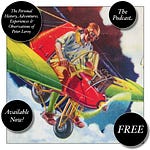
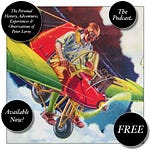
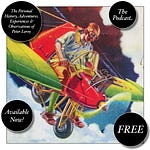
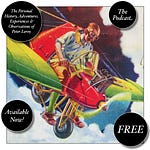

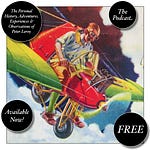
Share this post